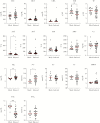Alterations in Blood Chemistry Levels Associated With Nipah Virus Disease in the Syrian Hamster Model
- PMID: 31747016
- PMCID: PMC7368165
- DOI: 10.1093/infdis/jiz552
Alterations in Blood Chemistry Levels Associated With Nipah Virus Disease in the Syrian Hamster Model
Abstract
Nipah virus (NiV; family Paramyxoviridae, genus Henipavirus) infection can cause severe respiratory and neurological disease in humans. The pathophysiology of disease is not fully understood, and it may vary by presentation and clinical course. In this study, we investigate changes in blood chemistry in NiV-infected Syrian hamsters that survived or succumbed to disease. Increased sodium and magnesium and decreased albumin and lactate levels were detected in animals euthanized with severe clinical disease compared with mock-infected controls. When subjects were grouped by clinical syndrome, additional trends were discernable, highlighting changes associated with either respiratory or neurological disease.
Keywords: Nipah virus; Syrian hamster; blood; neurological; respiratory.
Published by Oxford University Press for the Infectious Diseases Society of America 2019.
Figures


Similar articles
-
Comparison of the pathogenicity of Nipah virus isolates from Bangladesh and Malaysia in the Syrian hamster.PLoS Negl Trop Dis. 2013;7(1):e2024. doi: 10.1371/journal.pntd.0002024. Epub 2013 Jan 17. PLoS Negl Trop Dis. 2013. PMID: 23342177 Free PMC article.
-
Syrian hamsters (Mesocricetus auratus) oronasally inoculated with a Nipah virus isolate from Bangladesh or Malaysia develop similar respiratory tract lesions.Vet Pathol. 2015 Jan;52(1):38-45. doi: 10.1177/0300985814556189. Epub 2014 Oct 28. Vet Pathol. 2015. PMID: 25352203 Free PMC article.
-
In Situ Imaging of Fluorescent Nipah Virus Respiratory and Neurological Tissue Tropism in the Syrian Hamster Model.J Infect Dis. 2020 May 11;221(Suppl 4):S448-S453. doi: 10.1093/infdis/jiz393. J Infect Dis. 2020. PMID: 31665342 Free PMC article.
-
Emerging trends of Nipah virus: A review.Rev Med Virol. 2019 Jan;29(1):e2010. doi: 10.1002/rmv.2010. Epub 2018 Sep 24. Rev Med Virol. 2019. PMID: 30251294 Free PMC article. Review.
-
Nipah virus: epidemiology, pathology, immunobiology and advances in diagnosis, vaccine designing and control strategies - a comprehensive review.Vet Q. 2019 Dec;39(1):26-55. doi: 10.1080/01652176.2019.1580827. Vet Q. 2019. PMID: 31006350 Free PMC article. Review.
Cited by
-
Drivers and Distribution of Henipavirus-Induced Syncytia: What Do We Know?Viruses. 2021 Sep 2;13(9):1755. doi: 10.3390/v13091755. Viruses. 2021. PMID: 34578336 Free PMC article. Review.
-
Dynamic Changes of the Blood Chemistry in Syrian Hamsters Post-Acute COVID-19.Microbiol Spectr. 2022 Feb 23;10(1):e0236221. doi: 10.1128/spectrum.02362-21. Epub 2022 Feb 23. Microbiol Spectr. 2022. PMID: 35196799 Free PMC article.
-
Henipaviruses: epidemiology, ecology, disease, and the development of vaccines and therapeutics.Clin Microbiol Rev. 2025 Mar 13;38(1):e0012823. doi: 10.1128/cmr.00128-23. Epub 2024 Dec 23. Clin Microbiol Rev. 2025. PMID: 39714175 Free PMC article. Review.
-
Tissue replication and mucosal swab detection of Sosuga virus in Syrian hamsters in the absence of overt tissue pathology and clinical disease.Antiviral Res. 2023 Jan;209:105490. doi: 10.1016/j.antiviral.2022.105490. Epub 2022 Dec 12. Antiviral Res. 2023. PMID: 36521633 Free PMC article.
-
Emerging and reemerging infectious diseases: global trends and new strategies for their prevention and control.Signal Transduct Target Ther. 2024 Sep 11;9(1):223. doi: 10.1038/s41392-024-01917-x. Signal Transduct Target Ther. 2024. PMID: 39256346 Free PMC article. Review.
References
-
- Rockx B. Recent developments in experimental animal models of henipavirus infection. Pathog Dis 2014; 71:197–204. - PubMed

